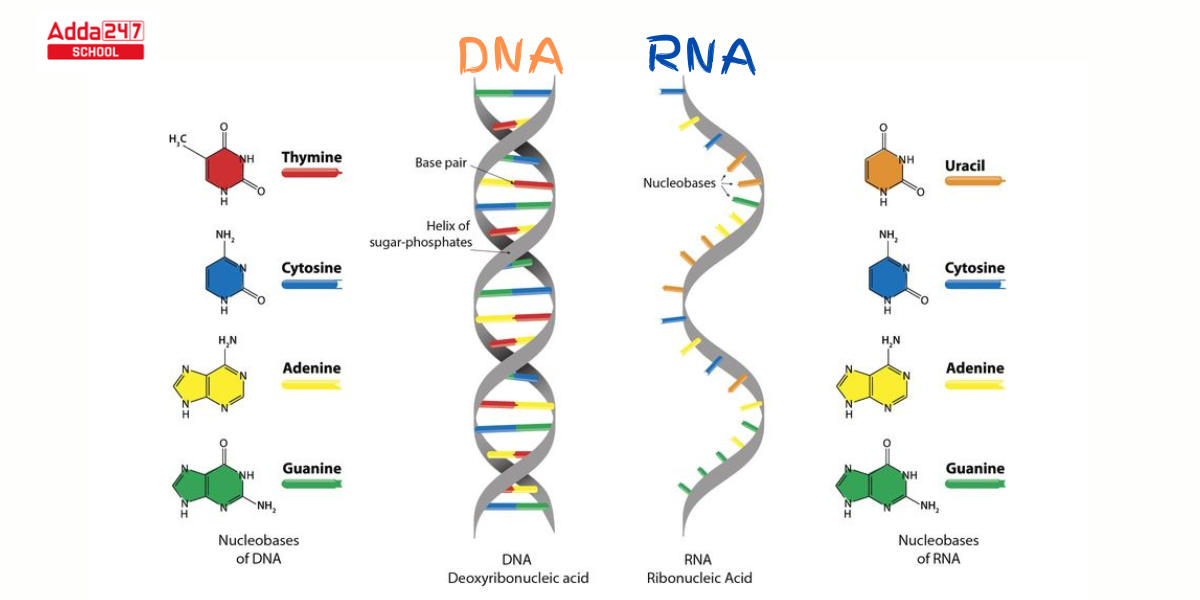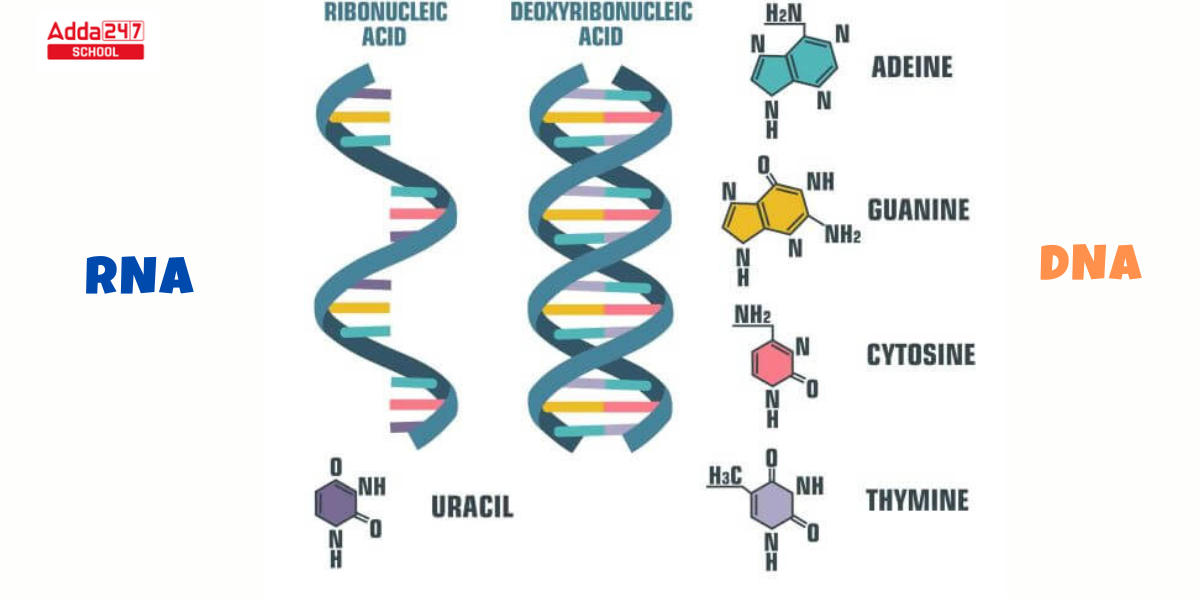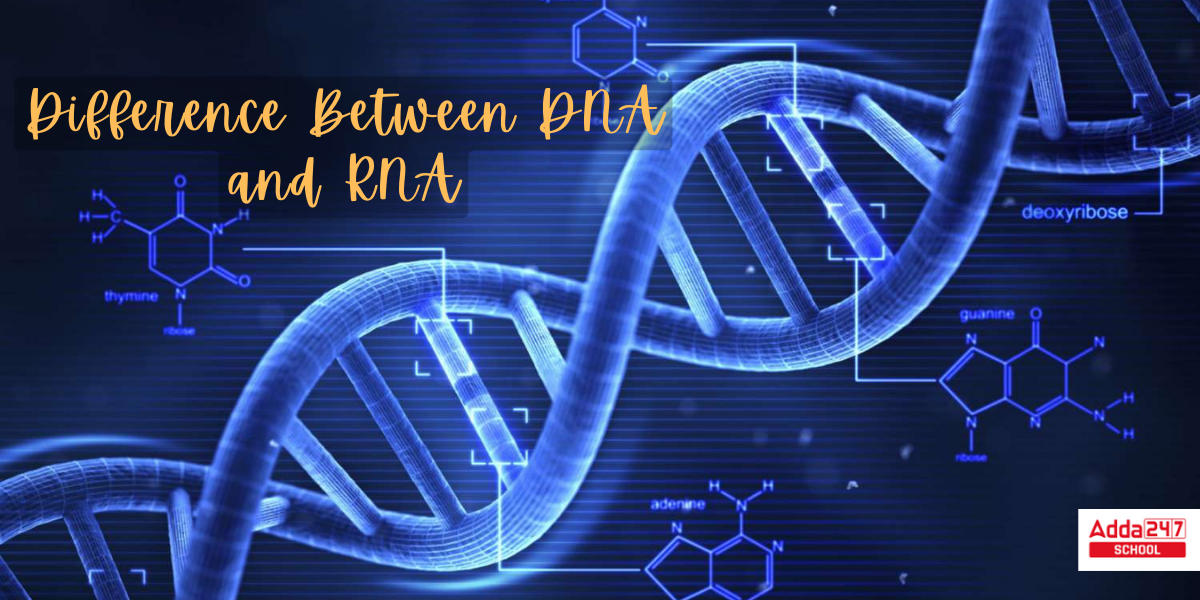The most crucial elements in molecular biology are probably deoxyribonucleic acid (DNA) and ribonucleic acid (RNA). All living species have hereditary material in the form of DNA and RNA. It is known as nuclear DNA because it is found in the nucleus of a cell. A little quantity of DNA, known as mtDNA or mitochondrial DNA, is also found in the mitochondria, whereas RNA is ribonucleic acid, which is found in all living cells.
DNA is in charge of storing and reading the genetic information that underpins all life. RNA carries DNA instructions that drive protein synthesis, however, in some viruses, RNA instead of DNA carries the genetic information. They are both linear polymers made up of sugars, phosphates, and bases, but there are some significant distinctions between them. The Difference Between DNA and RNA are comprehensively discussed in this article. Read the full article and leave your doubt in the comments.
Difference Between DNA and RNA
Lets we know first what are DNA and RNA first and their basic importance.
What is DNA?
The genetic material required for the growth, operation, and reproduction of all living things is found in DNA, a two-stranded helix-shaped molecule. DNA is made up of sugar deoxyribose, phosphates, and a unique sequence of nitrogenous bases called adenine (A), guanine (G), cytosine (C), and thymine (T). The arrangement of the nitrogenous bases in DNA, which is essential for protein production. The nucleotides are connected together to form two long strands that spiral to form an arrangement known as the double helix, which mimics a ladder with the sugar and phosphate molecules forming the sides, and the rungs formed by bases .
What is RNA?
Ribonucleic acid (RNA) is a nucleic acid that plays an important role in protein production. Its primary function is to act as a messenger for DNA instructions to govern protein synthesis. RNA is a single-stranded molecule that is required for protein production. RNA can be found in several forms, including messenger RNA (mRNA), transfer RNA (tRNA), and ribosomal RNA (rRNA).
DNA and RNA Diagram
DNA (Deoxyribonucleic Acid) and RNA (Ribonucleic Acid) are both nucleic acids, but they differ in structure and function. Below is a description of the key differences between DNA and RNA along with a diagram that represents these differences:

Difference Between DNA and RNA Structure
DNA and RNA are essential for preserving and transmitting genetic data from generation to generation. The chemical structure, functioning, and location of DNA and RNA within the cell are also distinct. All important Difference Between DNA and RNA are discussed below.

| Difference Between DNA and RNA | ||
| Particulars | DNA | RNA |
| Abbreviation | Deoxyribonucleic acid (DNA) | Ribonucleic acid (RNA) |
| Sugar | Deoxyribose sugar (2’OH) | Ribose sugar |
| Bases | Adenine, Thymine, Guanine, Cytosine – DNA |
Adenine, Uracil, Guanine, Cytosine – RNA
|
| strand | Usually double-stranded | Usually single-stranded |
| Location | Mostly found in the nucleus and mitochondria |
Found in the nucleus, ribosome, and cytoplasm
|
|
Predominant Structure
|
DNA is a double-stranded molecule with a long nucleotide chain. |
a single-stranded genetic material with a shorter nucleotide chain
|
| Stability | More stable and less prone to change |
Less stable and more prone to change
|
| Length | Longer and can have millions of base pairs |
Shorter than DNA and typically several hundred nucleotides long
|
| Transmission | DNA can duplicate itself; it is self-replicating. |
RNA does not duplicate itself. When needed, it is synthesized from DNA.
|
| Types | types of DNA – A-DNA, B-DNA, C-DNA, D-DNA, Z-DNA |
mRNA – Messenger RNA, tRNA -transfer RNA, rRNA – ribosomal RNA
|
| Mutation | UV light has the potential to harm DNA. Its mutation rate is relatively modest. |
RNA is less susceptible to UV radiation damage than DNA. It has a greater mutation rate than most.
|
| Function | Stores genetic information. The transmission of genetic information is the function of DNA. It serves as a long-term storage medium. |
RNA Acts as a template for protein synthesis. RNA transmitted the genetic code from the nucleus to the ribosome for protein synthesis.
|
DNA and RNA Difference
- DNA as well as RNA are made up of nucleotides, which are the molecules’ basic building blocks. DNA and RNA are nucleic acids that can be discovered in all living creatures.
- DNA is made up of nucleotides, which have a nitrogenous, phosphate, and sugar group. The sequence of the nitrogenous bases thymine (T), guanine (G), cytosine (C), and adenine (A) is critical in determining the genetic code.
- Ribose, phosphates, and the nitrogenous bases adenine (A), guanine (G), cytosine (C), and uracil (U) are all found in RNA. The nitrogenous bases A, G, and C are shared by DNA and RNA. Thymine is typically found solely in DNA, while uracil is typically found only in RNA.
Key Differences Between RNA and DNA
- Sugar Component:
- DNA: Contains deoxyribose sugar.
- RNA: Contains ribose sugar (which has an extra hydroxyl group compared to deoxyribose).
- Strand Structure:
- DNA: Double-stranded, forming a double helix.
- RNA: Single-stranded.
- Bases:
- DNA: Adenine (A), Thymine (T), Cytosine (C), Guanine (G).
- RNA: Adenine (A), Uracil (U), Cytosine (C), Guanine (G) (Uracil replaces Thymine).
- Function:
- DNA: Stores genetic information.
- RNA: Transfers genetic information and plays a role in protein synthesis (e.g., mRNA, tRNA, rRNA).
- Location:
- DNA: Found in the nucleus (in eukaryotes).
- RNA: Found in the nucleus and cytoplasm.
Other Related Posts –









 Madras University Result 2025 OUT at uno...
Madras University Result 2025 OUT at uno...
 CUET Geography Important Topics 2026 | B...
CUET Geography Important Topics 2026 | B...
 BCECE LE 2025 Counselling Dates Out, Che...
BCECE LE 2025 Counselling Dates Out, Che...









